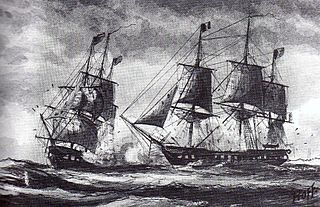USS Baltimore was a ship of the United States Navy.

The third USS Boston was a 32-gun wooden-hulled, three-masted frigate of the United States Navy. Boston was built by public subscription in Boston under the Act of 30 June 1798. Boston was active during the Quasi-War with France and the First Barbary War. On 12 October 1800, Bostonengaged and captured the French corvette Berceau. Boston was laid up in 1802, and considered not worth repairing at the outbreak of the War of 1812. She was burned at the Washington Naval Yard on 24 August 1814 to prevent her capture by British forces.

USS Constellation was a nominally rated 38-gun wooden-hulled, three-masted frigate of the United States Navy.
The first USS Eagle, a schooner, was built at Philadelphia, Pennsylvania, in 1798, and commissioned in the Revenue Cutter Service under the command of Captain H. G. Campbell, USRCS. She placed under control of the Navy in July 1798 for service in the undeclared naval war (Quasi-War) with France.
USS Ganges was a man-of-war in the United States Navy during the Quasi-War with France.

L'Insurgente was a 40-gun Sémillante-class frigate of the French Navy, launched in 1793. During the Quasi War with the United States, the United States Navy frigate USS Constellation, with Captain Thomas Truxtun in command, captured her off the island of Nevis. After her capture she served in the United States Navy as USS Insurgent, patrolling the waters in the West Indies. In September 1800 she was caught up in a severe storm and was presumed lost at sea.
USS Retaliation was the French privateer Croyable, built in Maryland, that then operated out of Santo Domingo. Delaware captured her on 7 July 1798 off New Jersey. She then served in the United States Navy during Quasi-War with France. Two French frigates recaptured her on 20 November 1798. The French Navy took her into service as Magicienne. However, Merrimack captured her on 28 June 1799. She served in the US Navy in the Caribbean briefly, before arriving in Philadelphia in August. She was paid off there and sold on 29 November.

USS Pickering was a brig, the 1st brig built for the UCRC Service, in the United States Revenue Cutter Service and then the United States Navy during the Quasi-War with France. She was named for Timothy Pickering, then the Secretary of State.
The first USS George Washington was a frigate in the United States Navy. She was named after United States Founding Father and President George Washington.
The second USS Delaware was a ship which served in the United States Navy during Quasi-War with France.
USS Merrimack, was a ship launched by an Association of Newburyport Shipwrights and presented to the Navy in 1798. She was the first ship of the Navy to be named for the Merrimack River. She saw action in the Quasi-War.

USRC Eagle was one of the first ten cutters operated by the United States Revenue-Marine, which later became the United States Revenue Cutter Service and later still became part of the United States Coast Guard.
USS Richmond was a brig purchased for the US Navy in 1798 by the citizens of Richmond, Petersburg, Manchester and Norfolk, Virginia, while being built at Norfolk as Augusta for a Mr. Myers. Renamed Richmond, she was fitted out in the fall of that year and in December stood out from Hampton Roads for the Caribbean with Captain Samuel Barron in command for service in the Quasi-War with France.

Berceau was a 22-gun corvette of the French Navy, built to a design by Jacques-Noël Sané, and launched in 1794. The Americans captured her in 1800 but restored her to France the next year. She then served in the Indian Ocean before returning to Spain, where she was broken up in 1804.

The Prudente was a 32-gun Capricieuse-class frigate of the French Navy.
USRC Scammel or sometimes referred to as Scammel II was a revenue cutter built in 1798 to serve in the Quasi-War with France. After completion she was transferred to the U.S. Navy and served in the West Indies naval squadron commanded by Commodore John Barry. While in Revenue-Marine service her captain was John Adams. In a letter dated 20 May, 1799 Navy Secretary Benjamin Stoddert notified the Treasury Secretary that he should consider her to be officially transferred to the U.S. Navy. In U.S. Navy service her first captain was Lieutenant Commander Fernald. She assisted the sloop USS Portsmouth in the capture of the French ship Hussar. After the war, the Navy retained Scammel until it was sold in 1801.
USRC Virginia was a schooner built in 1797 for the United States Revenue Cutter Service at Portsmouth, Virginia. At the outset of the Quasi-War in 1798, the only ships available to the Navy were the 10 ships of the Revenue cutter service, the largest of which was the Virginia. She was transferred to the Navy in 1798 and served in the Quasi War until 1800, when she was returned to the Revenue Cutter Service, recommissioned in 1802 and sold in 1807.

HMS Albacore was launched in 1793 at Rotherhithe. She captured several privateers and a French Navy corvette before she was sold in 1802.
USRC General Green was a cutter operated by the U.S. Revenue Cutter Service. She was named for the Revolutionary War hero Major General Nathanael Greene.







